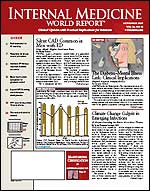Publication
Article
Internal Medicine World Report
Drug-Resistant Gene Migrated from East Coast to Midwest
Author(s):
By John Schieszer
CHICAGO—A gene that allows bacteria to resist an important class of antibiotics and was until now found only on the East Coast has for the first time been identified in microorganisms taken from patients at a hospital in St. Louis, researchers reported at the Interscience Conference on Antimicrobial Agents and Chemotherapy.
BlaKPC
Less than a decade ago, the gene was discovered on the East Coast in patients with bacterial infection.
At that time, bacteria with an active copy of this gene were found to resist carbapenems, a relatively new class of antibiotics effective against a wide variety of bacteria. Physicians generally reserve carbapenems for critically ill patients.
Enterobacteriaceae
In this new retrospective study, investigators used bacteremia isolates from Gram-negative bacteria that were obtained between August 1 and October 31, 2006, from a single institution.
Disk diffusion testing showed susceptibility to:
- Ertapenem (Invanz)
- Imipenem (Primaxin)
- Meropenem (Merrem)
BlaKPC
A real-time polymerase chain reaction (PCR) assay was used to detect , and the findings were confirmed by conventional PCR.
BlaKPC
Although the gene was found in only 4 of the 243 samples taken from 223 patients with bloodstream bacterial infections, this finding is a cause for concern, because spreads easily among bacteria, and the method most hospitals currently use to check for resistance genes does not detect all BlaKPC-positive strains.
"It's relatively easy for us to find this gene, but most hospitals don't have access to the same high-tech methods that we have at a major medical center," said lead investigator David Warren, MD, of Washington University School of Medicine, St. Louis. "To help slow the spread of this gene, we need to look at whether we can develop a more effective way to detect it."
BlaKPC
Klebsiella pneumoniae
was originally identified during an East Coast outbreak of . The gene is encoded on a DNA structure that can be easily copied and passed around, not just among bacteria of the same species but also from one species to another. Subsequent studies have demonstrated mortality rates as high as 50% in patients with this resistance gene.
Jonas Marschall, MD
BlaKPC
"We can't say much about 's effects on mortality here yet, because we only had 4 patients test positive for bacteria containing the resistance gene," said coinvestigator Jonas Marschall, MD, also with Washington University School of Medicine.
BlaKPC
He said infection with a bacterium carrying an active copy of the resistance gene does not mean that there are no remaining treatment options. However, the detection of can be key, both to successful treatment and to containing the spread of the resistance gene by isolating affected patients.
IMWR
"Our findings suggest that there is a worldwide distribution of this resistance gene going on, and there is expansion going across the United States, from the East Coast to the Midwest," Dr Marschall told . He added that although no recommendations can be issued at this point, all primary care physicians must be "aware of this resistance gene and the importance of testing for it."





